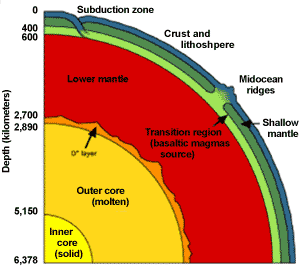Beneath the Surface
At the surface of the Earth, earthquakes and volcanoes give evidence of action taking place inside the planet. The plate tectonic theory explains these events, as well as the distribution of certain types and ages of rocks.
We are able to drill only a few kilometers into the ground. This is nowhere near deep enough to give us proof about the inner composition of our planet. However, we are able to get strong clues from seismology (the study of earthquakes) and seismics (the study of man-made waves).
The Earth is composed of three main layers of rock:
- The crust is a relatively thin layer around the outside of the Earth. It is about six to seven kilometers thick under the oceans, and it ranges from 12 to 60 kilometers thick beneath the continents. Like the shell of an egg, the Earth’s crust is brittle and can break.
- The mantle is about 2900 kilometers thick and is made mostly of melted rock.
- The core is made of two layers: an outer core of melted rock and an inner core of solid rock.
Rock gets hotter the deeper it is underground. As the rock of the mantle is melted, the colder, solid crust is actually floating on top of it.
The Earth’s crust overall is heterogeneous — that is, its composition changes depending upon the location. However, the crust under the oceans is homogeneous, composed entirely of basalts, and very magnetic. The rocks beneath the ocean have an average age of less than 20 million years. The oldest oceanic rocks are 117 million years old, which is still quite young in geological terms. Beneath the continents, the crust is heterogeneous, composed of many rocks (essentially granites) and not very magnetic. These rocks have an average age of 1 to 2 billion years, much older than the rocks beneath the oceans. The oldest known rocks are 3.8 billion years old.
|
Courtesy USGS The earth is made of layers of rock and metal, some of which are molten. The crust on which we live is a thin, brittle layer, like the shell of an egg. |
The crust and the shallow part of the mantle together are called the lithosphere. The lithosphere is rigid and about 100 kilometers thick. It is able to move about on the asthenosphere, the hotter, liquid layer directly beneath it. According to the plate tectonic theory, the lithosphere is not one solid block, but rather several pieces called plates. The plates are not attached to each other. They can move and push against each other in an organized way. The crust is like a jigsaw puzzle. Each piece is different, but together they make a clear picture.
What causes the plates to move?
|
Courtesy USGS The movement of continental plates around the Earth is thought to be due to slow convection currents in the melted rocks of the mantle. |
The mantle is a very deep layer of melted rocks called magma. The outer layer of the mantle cools when it meets the colder, solid crust above it and exchanges energy. Meanwhile, the inner layer of the mantle is getting warmer by exchanging energy with the very hot core beneath it. The result of this difference in temperature is a movement called convection. According to the plate tectonics theory, the plates move as a result of the slow convection currents moving beneath them.
The convection currents move magma toward the surface. As they move, they drag along the plates. The density of hot rocks is less than the density of colder ones. The less dense hot rock can rise through the crust and form a magnetic plume reaching to the surface. This is how a volcanic eruption begins.
This content has been re-published with permission from SEED. Copyright © 2025 Schlumberger Excellence in Education Development (SEED), Inc.



